Create a raised hot bed for spring and fall planting, simple raised bed gardening, or decoration with this simple method of hugelkultur.
Hugelkultur is an ancient form of composting that utilizes woody waste as the carbon substrata, to retain soil moisture and soil fertility. You can utilize the principles of hugelkultur by simply burying wood waste throughout your yard and garden, in order to increase the moisture holding capacity and fertility of your soil. It breaks down slowly over several seasons. A hugelkultur raised bed is a garden in its own right. It can be any size or shape that you wish, although most hugelkultur raised beds are rectangular.
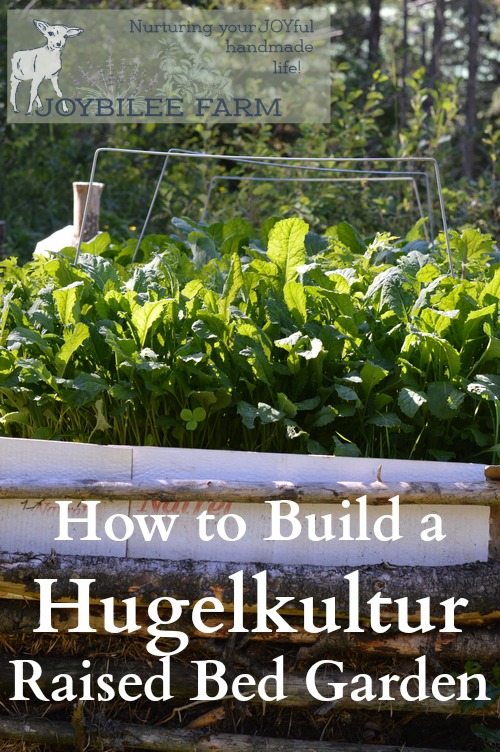
Hugelkutur raised beds rely on branches, rotting wood, wooden stumps, and waste wood, as the foundation of a raised garden bed. A hugelkultur bed is like a big compost pile. It is similar to lasagna gardening, but with the carbon inputs coming from wood waste. What I really like about hugelkultur gardening is that it utilizes a waste material — wood — that I have in abundance, making this a very frugal way to create a garden, where none existed. In fact, hugelkultur gardening is completely free, if you live where wood waste and manure or grass clippings are free. Most raised bed systems involve double digging, buying in materials for a framework, and then filling the bed with finished compost to get it ready for planting. The fertility of this kind of bed, lasts for the first season, and additional compost must be added annually to keep the bed productive. This is labour intensive and costly. On the other hand, hugelkultur beds utilize waste wood, fallen leaves, fresh or half rotted manure, grass clipping or weeds, and finished compost — all of which I have in abundance. The finished compost is only necessary if you plan to plant the bed immediately. One can build a hugelkultur bed using wood waste, leaves, needles, and grass clippings and let the compost break down naturally, planting it once the process is almost completed. The wood will break down slowly, over several seasons, while the nitrogen rich additives will heat up sooner and make the bed usable in a season, if its is kept wet. Further, once established, the hugelkultur bed is less work and doesn’t not need to be re-fertilized annually, as the break down of the wood adds soil fertility to the bed for many years.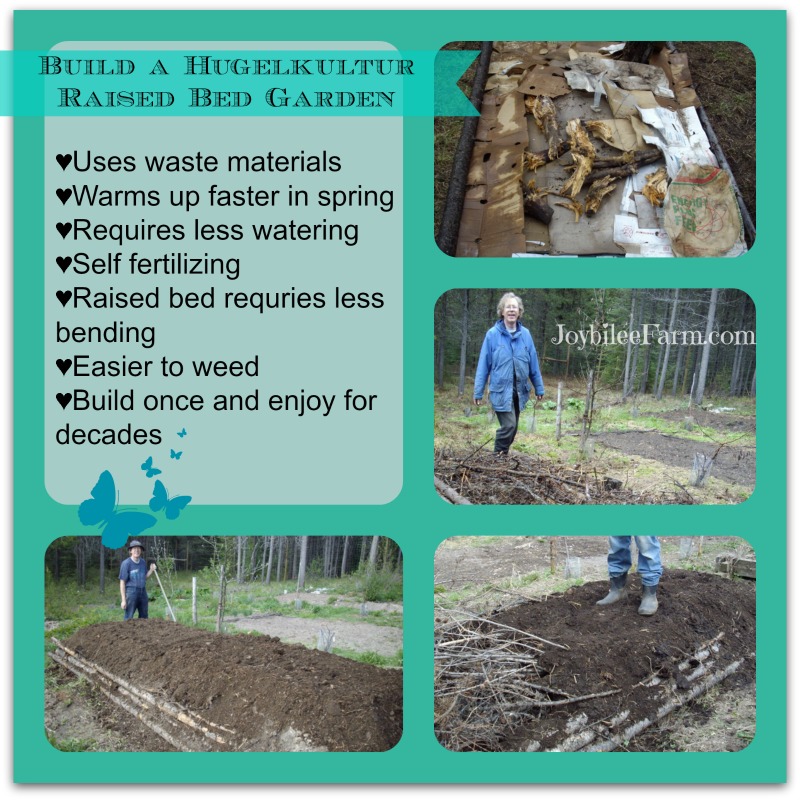
Benefits of Hugelkultur raised bed gardens
1. Warmer than the surrounding soil
A hugelkultur bed is a decomposing compost pile. So it generates heat. This makes the soil warmer than the surrounding soil.
2. Breaks down over time and so maintains fertility
The wood waste breaks down slowly over several years and so the bed maintains its fertility. It doesn’t have to be amended every season.
3. It is a carbon sink.
By putting wood into the ground, the hugelbeds remove carbon from the atmosphere and recycle it to be used as a growing medium and plant fertilizer.
4. Hugelkultur beds are ready to plant, earlier than the surrounding soil.
Raised beds are ready to plant earlier than the surrounding soil. The snow melts off earlier, and the bed stays warm later into the year, so it is great for both extending the fall growing season, and getting a jump on spring planting.
5. Hugelkultur beds have a natural frost drain.
Cold air falls to the lowest point, so hugelcultur raised beds, are surrounded by a frost drain, which is important in Northern areas, lengthening the growing season.
6. Plants on a hugelkultur bed can be planted closer together.
Hugelkultur beds lend themselves to intensive methods of gardening, as they maintain moisture, as the wood holds water. And they are fertile.
7. Hugelcultur beds are easier to weed.
The beds are higher and so they can be weeded in a standing position. Starting them with clean soil and hot compost also helps reduce weeds, and a heavy mulch can make them almost weed free for the first seasons.
8. Hugelkultur beds are easier to manage for the elderly and handicapped.
Since the beds are higher they require less bending and stooping to plant, weed, maintain, and harvest.
9. When part of a permaculture forest garden, hugelkultur beds can be seeded with mushroom spawn, and will provide additional food growing areas.
If you plan this into your bed, by using woods that are favourable to certain mushrooms, you can have a successful mushroom crop in addition to fruits and vegetables.
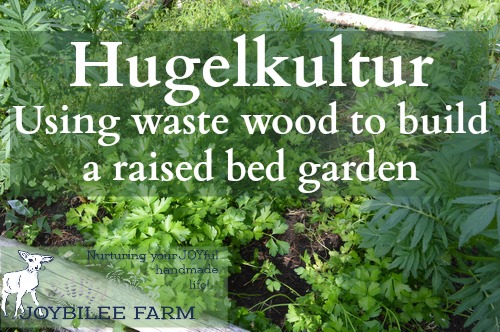
How to build a Hugelkultur bed:
The hugelkultur bed seems to be in vogue right now. When I mentioned that I was utilizing the multitude of waste wood at Joybilee Farm to create a raised bed, hugelkultur garden, it seemed that everyone around me had already made a few or knew someone who had. The community garden, in Grand Forks, BC had a hugelcultur workshop this spring. The neighbor down the road just built one in her yard, and there’s a folk figure in Midway that knows everything there is to know about hugelkultur. So I enter the community of hugelbed gardeners, following in the footsteps of a movement toward permaculture, and sustainable gardening.
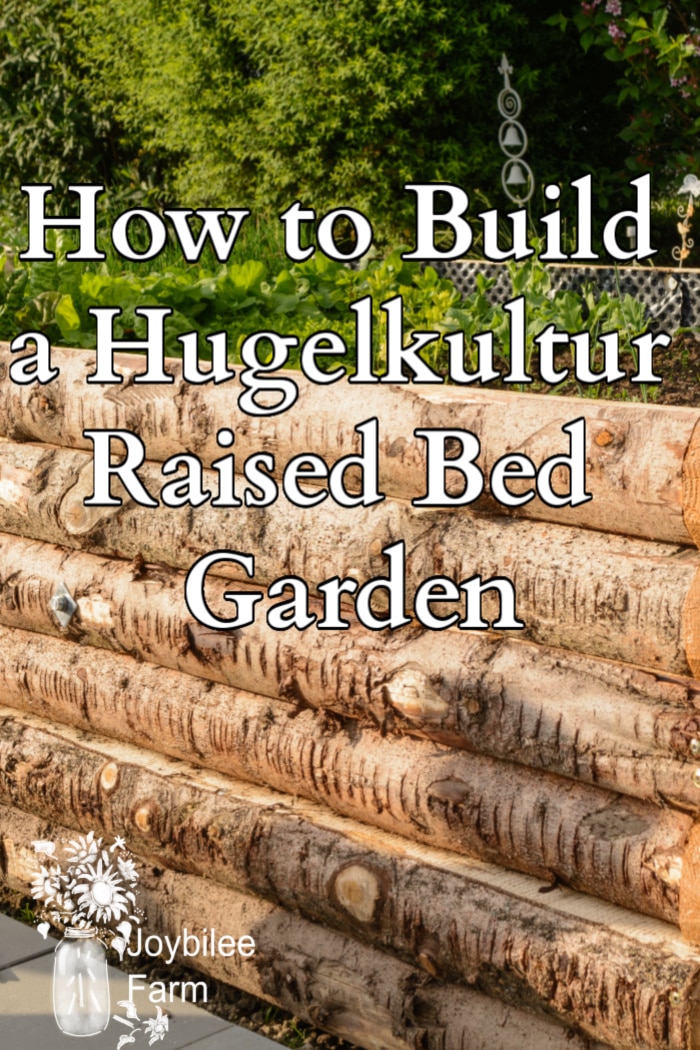
When considering to build a sustainable, frugal, raised bed garden using permaculture and hugelkultur techniques, forget the Lee Valley Catalogue and the manicured, tame, and expensive raised beds made from planed lumber, and purchased corner braces. Forget the truck loads of bought top soil and steer manure (manufactured from GMO-Corn fed steer waste, no doubt). Vegetable gardening needs to be affordable and a little less tame. We live in a forest so there is a lot of waste wood lying around. In other years we have burned the waste wood, or at least planned to. There are piles of waste wood, all over our 140 acres that someone planned to burn at some time. We also have a chipper. Its noisy. And uses gas. And once we chip the wood, there aren’t too many places that we can use it, with no lawns and no fancy-smanzy, polite flower gardens. We do have goats after all, which keep my excursions into beautiful flower gardens to a minimum. This week they ate down the daffodils. just as they were coming into flower.
Some strong builders of hugelkultur beds begin by double digging the bed below the surface of the surrounding soil. We just laid down cardboard on the forest floor. The wood we used was from the area that we cleared when we put in our garden, closer to the house. The other garden, is susceptible to frost any day of the year, and so we thought by moving the garden uphill that we might actually get a few weeks of frost free growing. Still waiting to see that work out.
1. First layer: Cardboard, well soaked. You could also use several layers of newspaper, or waste straw or waste hay. You are basically blocking the sod and weeds from growing up through the wood. After a year, the underlying sod will die back and it will no longer be an issue, after this layer breaks down. You could also use leaf mould, or straw. Don’t use a commercial weed block, as it would also block subsoil moisture and you will need that to peculate through your bed.
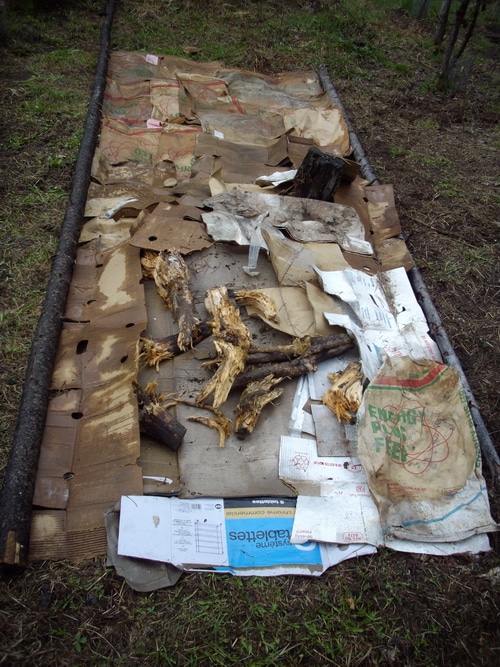
The first layer of the Hugelkultur bed is cardboard and paper. This offers a base and defines the bed. Its optional.
2. Second layer: Waste wood, branches from firewood, fallen twigs, stumps, partly rotted wood. At least 3 feet deep. Wet it well with a hose before proceeding. The internal moisture is key to keeping the bed warm, and decomposing. At this stage you can place long, narrow trunks of trees to act as a barrier for the bed and keep your branches and soil in place. You can support them with stakes, placed in the ground at critical areas.

The second layer is wood waste. This can be brush, twigs, logs, whatever you have laying around your homestead.
3. Third layer: Half composted manure, pressed between the branches of waste wood. We piled on the manure and jumped up and down on the pile to get it inside the wooden branches. This was the most labour intensive part of the process. Shovel the half composted manure into the spaces between the branches, then jump up and down on the pile to pack it in. It needs to be packed solidly to encourage the break down of the wood. Wet again to soak the pile well. If you don’t plan to plant the bed right away, instead of half composted manure, you can use grass clippings, fresh manure, or any other nitrogenous addition that you would put in a compost pile. Intersperse with some wood ashes and bio-char if using acidic woods like pine, or add small portions of lime and magnesium salts do help with balancing fertility and acidity.
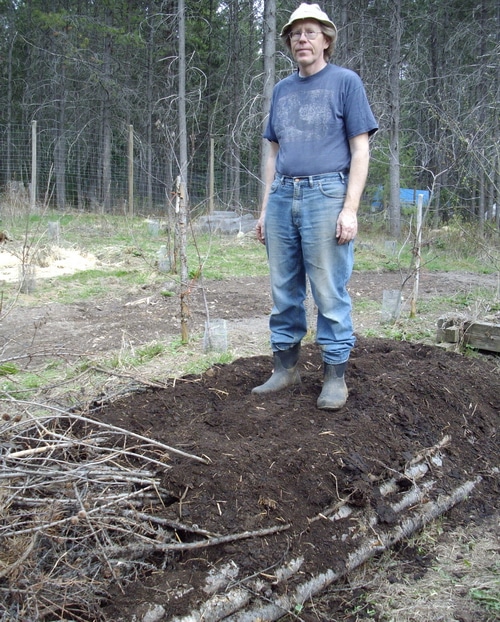
The 3rd layer is half finished compost Stomp it down to get it in between the wood base. The more solid that you pack it the better.
4. Fourth Layer: Pile finished compost over it all, to a depth of 6 inches. Soak it all well. It can be planted immediately. Place the finished compost on the top and smooth the top to get it ready for planting. Our bed was 25 feet long and 4 1/2 feet wide. It was placed on a hill so Robin terraced the bed in the middle, so that the water wouldn’t run off.
5. Fifth Layer: Straw mulch. After planting place a straw mulch on the bed to hold in moisture and make weeding easier.
6. Finally, dig a trench all the way around the bed to drain water from the surrounding area and guide it into the bed, to help the wood maintain its moisture level.
7. Plant with trees, bushes and vegetables. Trees planted on a hugelkultur bed will root downward and eventually make contact with the subsoil. Consider the pH of the trees used in the bed. Pine trees are acidic and will increase soil acidity as they break down, for instance, making it a really good medium for blueberries and other acid lovely fruits.
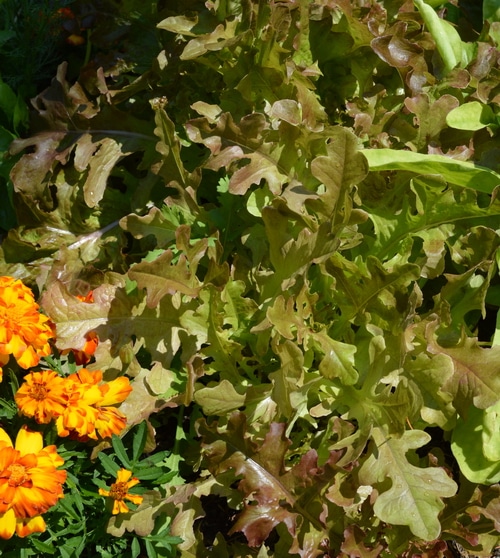
That’s the basics of making a hugelkultur bed: Carbon from wood waste and nitrogen from grass clippings, manure, or weeds. Firmed up into a raised bed garden. For the elderly this kind of garden can be made taller in order to be worked from a standing position. Hugelkultur is an affordable way to create a garden from waste materials, with the potential for less work and sustainable fertility over many years.
Over the years, as the wood breaks down inside the bed, the soil level will drop. You can top this up with the regular application of mulch or with additional finished compost. Both will add additional fertility to the bed.
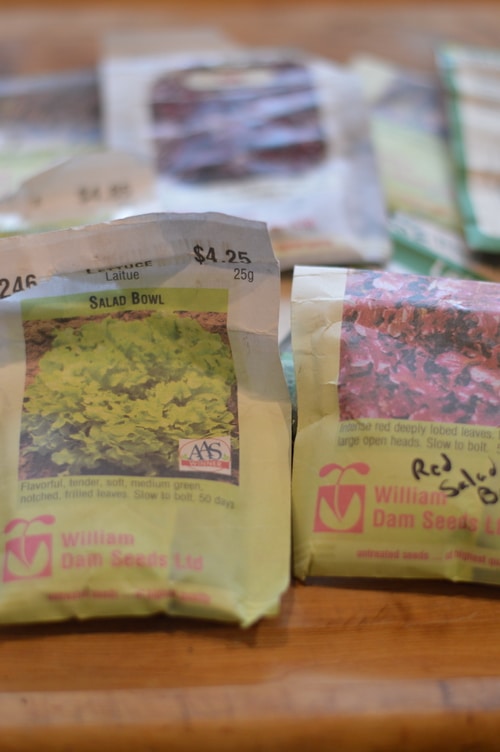
Other hugelkultur Ideas
A Design for an Improved Hugelkultur Raised Bed Garden for Older Gardeners
How to Garden In Winter without a Greenhouse
Growing Mesclun Salad Greens in a Hugelkultur Raised Bed
Your Turn:
What’s your method for building a new garden without spending a lot of money to get it right? Leave a comment.


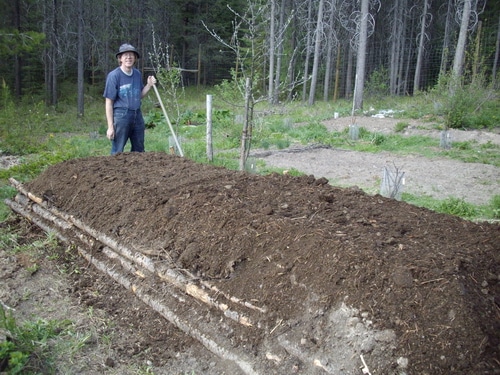

No. In order for the wood to decompose and create rich hummus the wood must have contact with the ground microbes.